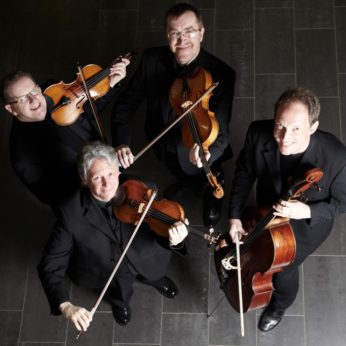The string quartet is an uncompromising medium. It was always the most intellectual musical form – the most difficult, the most challenging, the one least likely to pander to popular taste. In Haydn’s day, string quartets were intended for a small circle of educated and aristocratic connoisseurs; and if they became popular it was certainly despite their impressive intellectuality, and not because of it. Haydn’s audience would have been musically sophisticated, although his later quartets were written with the concert halls of London in mind, as opposed to the palace at Esterhazy. One contemporary description of a subscription concert in Vienna in 1808 puts this elitist argument in a nutshell: Actually there was not a large assembly there, but one consisting of very zealous and attentive music lovers. And that is the proper public for this finest and most intimate of all music associations.
Haydn’s Op.77 dates from 1799, when the string quartet was a generation old. Since the 1760s he had composed set after set of masterpieces, and since 1785, so had, on a smaller scale, Mozart. The Vienna of 1799 was also home to the young Beethoven, an ex-student of Haydn’s, who was already creating a stir with his early piano trios and sonatas. Both of them were supported by the same patrons like Count Apponyi, Prince Lobkowitz, Baron Zmeskall, Prince Lichnowsky and Count Razumovsky, names still famous on account of their association with the three great classical composers. In 1798 Beethoven started work on his Opus 18 set of string quartets, which was eventually completed in 1800. So while Haydn was composing his last quartet, Beethoven was writing his first, a touching symmetry, which was taken up at the end of the next century when Brahms’ last works coincided with Schönberg’s first.
This F major quartet is Haydn’s last completed instrumental work. The third quartet in this set was never completed; all we have are two beautiful middle movements, closed with the quote: Gone is all my strength, old and weak am I. Although he was nearly seventy when he wrote these works, the music has the wit and energy of a thirty-year-old, while his mastery of the form carries the inevitable stamp of authority and experience. For instance the finale shows an effortless weaving together of sonata form, German dance and Hungarian gypsy figures in a brilliant combination of wild, flashing energy and rigorous intellectual coherence. This is a perfect foil to Haydn’s restrained and melancholy slow movement with its fastidious two-part writing and its unpathetic, undemonstrative, undeclamatory style. If you go from here to Beethoven’s first quartet, also in F major, you enter another world – Adagio affetuoso ed appassionato – with its passionate outbursts and lack of restraint. The cusp of the new century is clearly telling us what we shall gain and what we shall leave behind.
